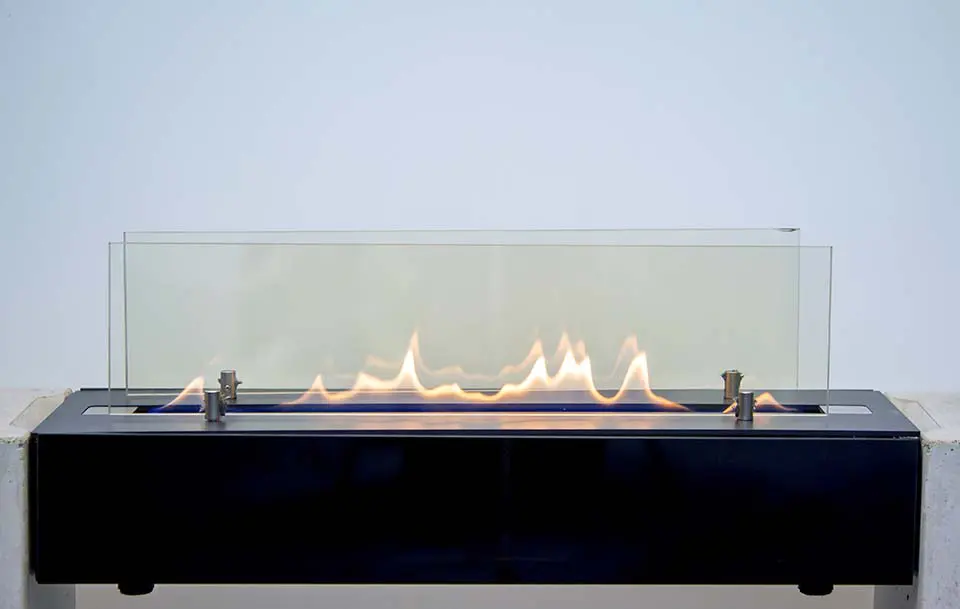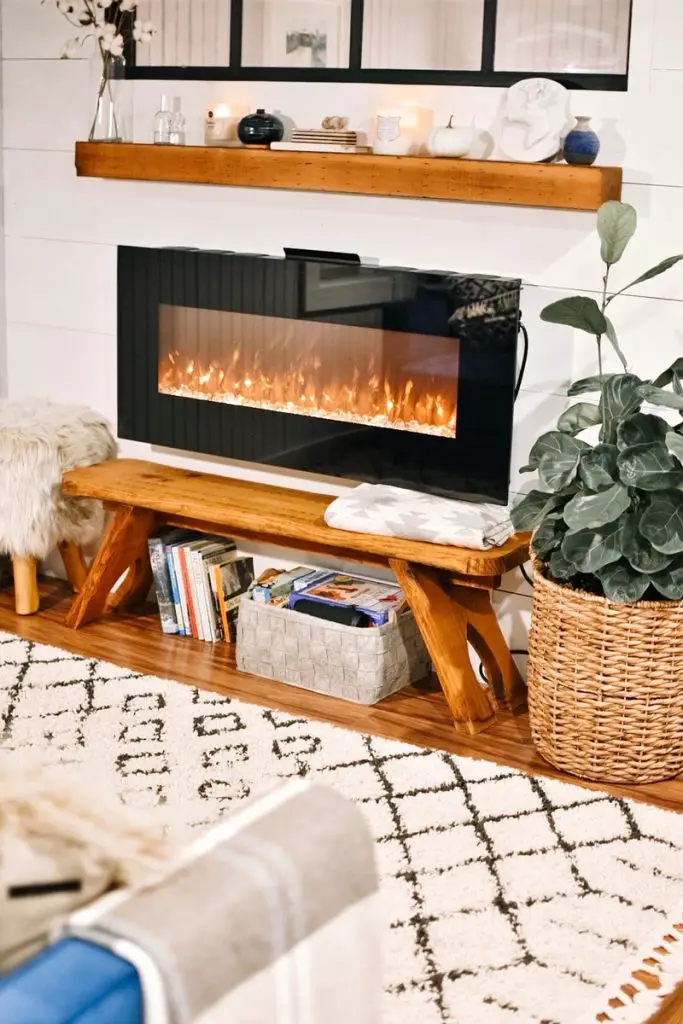- First, turn your gas fireplace’s knob from the “Off” to the “Pilot” position.
- Push in the pilot knob, which will then manually send gas into the system.
- Push the igniter button once every second until it lights. Depending on how long it’s been since the gas fireplace was last used, ignition may take several attempts before igniting.
- After the pilot lights, keep the pilot button held down for about 15 to 30 seconds to warm up the thermocouple and ensure that the flame stays lit. Different units may require slightly different durations for how long you’ll need to hold down the button for.
- Release the pilot knob. If the flame stays lit, then you’ll rotate the knob to the “On” position.
- If available, you can adjust the flame- colors and size, etc.
- Reattach the cover or screen over your control panel. (Source)
Contents
- Video Guide: Starting A Gas Fireplace
- Step 1: Read the user’s guide carefully
- Step 2: Locate the control panel on the fireplace and open it
- Step 3: Turn off the control knob for about 5 minutes
- Step 4: Twist the shutoff valve to make it bring it parallel to the gas line
- Step 5: Turn the control knob to a pilot position
- Step 6: Turn on the ignition and press down the control knob
- Step 7: Hold down the control knob for about 30 seconds
- Step 8: Turn the control knob to the “on” position
- How to operate an electronic pilot in a gas fireplace
- What you should know
- Conclusion
Video Guide: Starting A Gas Fireplace
The pleasure of having a gas fireplace is unmeasurable (read more about them here). There is no need to look for dry wood, carry it home, and chop it up before placing it in the fireplace.
A gas fireplace is a simple method to bring warmth to any space or living room hassle-free- learn how much it costs to install a gas fireplace here.
Fireplaces that use gas produce heat and cool atmospherics without leaving an ash mess. These household devices are easy to operate and only necessitate a few minutes to get up and running using a natural gas line or propane tank.
But, the main question is how to start a gas fireplace and relight the pilot. Many are in a dilemma on how they can handle this effectively.
Don’t fret if you are one individual who doesn’t know how the process goes. This guide will take you through the steps to start a gas fireplace and relight the pilot. So, continue reading.
If you’re starting a gas fireplace for the first time, read our guide!
Step 1: Read the user’s guide carefully
Read the manufacturer’s instructions thoroughly before lighting/adjusting your fireplace. Though many fireplaces tend to use similar ignition techniques, yours might have a unique feature that might lead to severe problems when mishandled.
Step 2: Locate the control panel on the fireplace and open it
A control panel is included in most modern gas fireplaces. This panel, which is generally concealed behind the fireplace’s front screen, can be opened or removed to access it for aesthetic reasons. The screen on most gas fireplaces can be removed simply by pulling it off the device.
Step 3: Turn off the control knob for about 5 minutes
On the control panel, look for the knob. Usually, it’s written, “on, off, and pilot.” Turn the knob to the “off” position. Allow at least 5 minutes for any extra or remaining gas to dissipate after turning the knob to “off” and removing your fireplace’s cover.
Step 4: Twist the shutoff valve to make it bring it parallel to the gas line
A shutoff valve is a safety precaution included in some fireplace models to control the amount of gas released by your device. If your fixture contains one of these valves, make sure it’s positioned until the handle is parallel with the gas line so that fuel may enter the firebox.
Step 5: Turn the control knob to a pilot position
The knob should be twisted to expose the pilot light, which will give you access to the fireplace’s little flame. Do not twist the knob until you are ready to ignite the pilot light to prevent any unwanted calamities.
Step 6: Turn on the ignition and press down the control knob
To start the blaze, press your finger into the center of the control knob and hold it in place. Then, press the ignition switch on the fireplace, frequently a red button near the control knob. Tap the switch several times until the pilot light ignites. If your pilot light fails to light after several tries, restart the process and try again. If nothing happens, look for any known ignition issues or get help from a specialist.
Step 7: Hold down the control knob for about 30 seconds
To keep the fire going, hold the control knob for a minimum of 30 seconds, possibly longer if necessary. This will give the thermocouple a safety mechanism that cuts off the gas supply if the pilot flame goes out, time to warm up, and establish that the pilot is back on.
Step 8: Turn the control knob to the “on” position
Turn the control knob on your fireplace from the “pilot” position to the “on” position once you’ve lit the pilot light. This will ensure that the pilot light stays burning indefinitely, allowing you to use the device’s wall switch or remote control to turn on the fireplace whenever you like. When you’re done, replace the fireplace’s front screen if it was removed.
How to operate an electronic pilot in a gas fireplace
Turn on the gas fireplace’s supply line. Ensure the electric switch is on if you have an electronic setting that controls the unit’s temperature. Look for the control knob labeled “pilot ignite.” If you have a unit that enables you to regulate the temperature, it will have: on, off, and electronic settings. Turn it off for a few minutes.
Slowly rotate the knob to the start position. It may be necessary to apply downward pressure for it to turn. Place the knob next to “pilot” or “pilot ignite” and hold it down until a little gas escapes. After that, press the igniter button. When you hear a clicking, sparks are being transmitted to the gas. Continue to push the “pilot ignite” control while releasing the igniter button.
If it doesn’t light after 10 seconds, push the igniter button again. When it does light up, release the “pilot ignite” knob. Turn the knob to “on” if you want it constantly or to “electronic” if that setting is available to adjust the room’s temperature.
A standing pilot light is a small flame that burns even when using the fireplace in most gas fireplaces. This makes it simple to start the fireplace when it’s cold outside, but shutting off the pilot while it warms up is a good idea.
What you should know

If the pilot tube has air in it, it’s difficult to light. However, after numerous tries, the fireplace should ignite. If you notice that the pilot light needs to be lit frequently, check the end of the tube for debris.
If the pilot is challenging to start and you begin to smell gas, wait for the gas to dissipate before attempting again. It’s not recommended that you try to light it back up while there’s still a strong gas odor, so wait a few moments before attempting to relight the pilot.
In a gas fireplace, the pilot light is what helps to start the fire. It might be inadvertently blown out by wind from the chimney. Some people switch it off when they know they will not be utilizing the fireplace for aesthetic reasons.
Conclusion
The technique for relighting the pilot on your gas-burning fireplace is determined by the type of pilot you have; electronic or flame-lit. It isn’t difficult, but it may be perplexing if you’ve never done it before. The above are steps on how to start a gas fireplace and relight the pilot.

